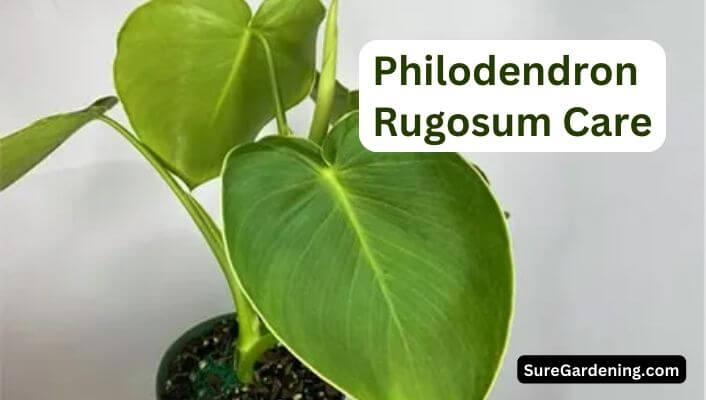Philodendron Rugosum, with its heart-shaped glossy leaves and attractive climbing habit, has become a beloved choice for both novice and experienced indoor gardeners.
Providing the right care to your Philodendron Rugosum is essential to ensure it thrives and graces your living space with its vibrant green foliage.
In this guide, we will delve into the intricacies of Philodendron Rugosum care, exploring everything from its ideal growing conditions to propagation techniques and pest management.
Post Contents
- Getting to Know Philodendron Rugosum
- Selecting the Right Location
- Potting and Soil Requirements
- Watering Techniques
- Humidity and Environment
- Fertilization Tips
- Pruning and Maintenance
- Propagation Methods
- Pest and Disease Management
- Support and Training
- Repotting and Transplanting
- Seasonal Care Guide
- Troubleshooting Common Issues
- FAQs:
- Important FAQs:
- 1. How often should I water my Philodendron Rugosum?
- 2. Can I place my Philodendron Rugosum in direct sunlight?
- 3. What should I do if my Philodendron Rugosum’s leaves turn yellow?
- 4. How can I propagate my Philodendron Rugosum successfully?
- 5. How do I prevent pests from infesting my Philodendron Rugosum?
- Conclusion
- Author
Getting to Know Philodendron Rugosum
Native to the rainforests of South America, Philodendron Rugosum is a tropical beauty known for its unique appearance. Its large, deeply-veined leaves set it apart from other houseplants, making it a standout addition to any collection.
In its natural habitat, it often climbs trees for support, displaying its aerial roots and elegant trailing vines.
Selecting the Right Location
Before bringing your Philodendron Rugosum home, it’s vital to choose the perfect spot. This plant thrives in bright, indirect light, simulating the filtered sunlight it enjoys under the canopy of the rainforest.
Avoid placing it in direct sunlight, as it can lead to leaf burn. Additionally, maintaining a temperature range between 65°F to 80°F (18°C to 27°C) is optimal for its growth.
Potting and Soil Requirements
In order for your Philodendron Rugosum to thrive, you need to choose the right pot and soil mix. It’s crucial to choose a pot with lots of drainage holes to ensure optimal growth and health. By doing this, water doesn’t collect at the roots, reducing root rot and other problems.
A good soil mix for Philodendron Rugosum involves replicating its natural habitat. Peat moss, perlite, and orchid bark create a nutrient-rich environment that looks like it’s in its natural habitat. Perlite promotes aeration and keeps soil from compacting, while peat moss keeps moisture in place.
In addition to improved drainage, orchid bark provides organic matter to support healthy root development. Together, this soil mix provides the perfect foundation for your Philodendron Rugosum to flourish and thrive.
Watering Techniques
To ensure optimal growth of Philodendron Rugosum, it is essential to adopt the right watering practices. Proper watering is an essential aspect of Philodendron Rugosum care, directly impacting its overall health. The roots need oxygen to develop robustly, so water when the top inch of soil becomes dry.
If your Philodendron Rugosum is growing in a dry indoor environment or during warmer months, it may require more frequent watering, whereas it may require less watering when the indoor environment is cooler or more humid.
A healthy and vibrant Philodendron Rugosum requires a delicate balance between moisture levels. Overwatering can cause root rot and wilting, while underwatering causes browning and drying of the leaves. To nurture a thriving plant, monitor the soil diligently and tailor your watering routine accordingly.
Humidity and Environment
Since Philodendron Rugosum is native to tropical regions with high humidity levels, it needs a humid environment. Use a humidifier or place a water-filled tray near the plant to maintain this environment.
It is also important not to expose the plant to drafts or sudden temperature fluctuations, which may stress the plant. To further protect the plant, it is recommended to mist it regularly to help maintain optimal humidity levels. It is also important to keep the soil moist but not wet to avoid root rot.
Fertilization Tips
Fertilization is a crucial aspect of caring for your Philodendron Rugosum plant to support its growth and maintain its lush foliage. When it comes to fertilization tips, it is recommended to use a balanced liquid fertilizer formulated for houseplants.
It is recommended that you fertilize your Philodendron Rugosum every 2 to 4 weeks between spring and early fall. Avoid over-fertilizing as this can lead to nutrient imbalances and potential damage to the plant.
The exact amount of fertilizer your plant needs depends on its growth rate and appearance. By providing the right nutrients in moderation, you can ensure a thriving and vibrant Philodendron Rugosum.
Pruning and Maintenance
Maintaining Philodendron Rugosum plants requires regular pruning and maintenance to keep them in peak condition. By removing dead or yellowing leaves, regular pruning promotes new growth and prevents the plant from losing its attractive appearance.
By trimming unruly vines and stems, you prevent the plant from becoming tangled and enhance its overall aesthetics. Additionally, dusting the leaves regularly ensures a better absorption of light.
During maintenance, the plant must also be inspected for signs of pests or diseases and immediately addressed if any emerge. Your Philodendron Rugosum can thrive and become a captivating centerpiece in your indoor garden if you devote time to proper pruning and maintenance.
Propagation Methods
Propagation of Philodendron Rugosum can be a rewarding experience for plant enthusiasts.
There are two primary methods for propagating this beautiful plant: stem cuttings and division.
If you are making a stem cutting, select a healthy stem with at least one node and cut it just below the node with a sharp, sterilized knife or scissors. Removing leaves near the bottom will help the cutting root successfully.
Providing the cutting with indirect light and high humidity, place it in a well-draining pot with moist soil mix. To divide the plant, carefully separate it into smaller sections, ensuring each has its own healthy root system. Plant the divisions in separate pots with suitable soil and care for them as they grow.
Pest and Disease Management
While Philodendron Rugosum is relatively hardy, it can still fall victim to pests and diseases. Common pests include spider mites, mealybugs, and aphids. Implementing natural remedies or using insecticidal soap can help control these invaders.
Additionally, being vigilant about signs of diseases like leaf spot and root rot is essential for early detection and treatment.
Support and Training
As Philodendron Rugosum grows, it may require support and training to maintain its shape and prevent trailing vines from tangling. Gentle tying and trellising can be employed to guide the plant’s growth direction and create an aesthetically pleasing display.
Repotting and Transplanting
The repotting and transplanting of your Philodendron Rugosum are vital processes for the health of your plant. Growing Philodendrons may outgrow their current pot, and repotting becomes necessary to provide them with more space and nutrients.
In contrast, transplanting involves moving a plant to a different location or environment, such as from an indoor to an outdoor setting. Both procedures require gentle handling to avoid stressing the roots.
You can determine when to repot or transplant Philodendron Rugosum by observing signs of root-bound conditions and limited growth.
Seasonal Care Guide
Different seasons call for slight adjustments in care routines. During winter, reduce watering and avoid placing the plant near cold windows. In summer, provide extra humidity and ensure adequate watering to support growth.
Troubleshooting Common Issues
Yellow leaves, brown tips, and stunted growth are common issues that can arise when caring for Philodendron Rugosum. Understanding the root causes of these problems and addressing them promptly can save your plant from further damage.
FAQs:
Important FAQs:
1. How often should I water my Philodendron Rugosum?
Proper watering frequency depends on factors such as environmental conditions and the size of the plant. As a general rule, water your Philodendron Rugosum when the top inch of the soil feels dry to the touch.
2. Can I place my Philodendron Rugosum in direct sunlight?
No, Philodendron Rugosum prefers bright, indirect light. Placing it in direct sunlight can lead to leaf burn and damage the plant.
3. What should I do if my Philodendron Rugosum’s leaves turn yellow?
Yellow leaves can indicate overwatering, underwatering, or nutrient deficiencies. Adjust your watering routine, check the roots for signs of rot, and consider fertilizing if necessary.
4. How can I propagate my Philodendron Rugosum successfully?
Philodendron Rugosum can be propagated through stem cuttings or division. Choose healthy stems or root clumps, follow the correct propagation process, and ensure adequate care for the new cuttings.
5. How do I prevent pests from infesting my Philodendron Rugosum?
Regularly inspect your plant for signs of pests and take immediate action if any are found. Implement natural remedies or use insecticidal soap to control pest infestations. Additionally, maintaining a clean and healthy environment helps prevent pest problems.
Conclusion
In conclusion, Philodendron Rugosum is a delightful plant that brings a touch of the tropics to any space. With proper care and attention to its specific needs, you can enjoy its beauty and watch it thrive.
Remember to provide the right light, humidity, and nourishment, and your Philodendron Rugosum will reward you with lush green foliage and a vibrant presence.

